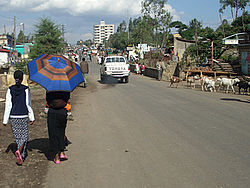Ambo, Ethiopia
|
Ambo Hagere Hiwot |
|
|---|---|

Downtown Ambo (March 2006)
|
|
| Location within Ethiopia | |
| Coordinates: 8°59′N 37°51′E / 8.983°N 37.850°ECoordinates: 8°59′N 37°51′E / 8.983°N 37.850°E | |
| Country | Ethiopia |
| Region | Oromia |
| Zone | West Shewa |
| Elevation | 2,101 m (6,893 ft) |
| Population (2012) | |
| • Total | 94,342 |
| Time zone | EAT (UTC+3) |
| Area code(s) | 11 |
| Climate | Cwb |
Ambo (also known as Hagere Hiwot) is a spa town and separate woreda in central Ethiopia. Located in the West Shewa Zone of the Oromia Region, west of Addis Ababa, this town has a latitude and longitude of 8°59′N 37°51′E / 8.983°N 37.850°E and an elevation of 2101 meters.
Ambo is known for its mineral water, which is bottled outside of town; it is reportedly the most popular brand in Ethiopia. Nearby attractions include Mount Wenchi to the south with its crater lake, and the Guder and Huluka Falls. Ambo is also the location of a research station of the Ethiopian Institute of Agricultural Research; initiated in 1977, this station hosts research in protecting major crops in Ethiopia. The town's market day is Saturday.
After Lij Iyasu was captured, he was held for a while at Ambo, before being transferred to house arrest at Fiche. In the early 1930s, Mahtama Selassie Walda Mesqal, who had studied agriculture in France and Spain, started an agricultural station near the town. By 1933, Ambo had started to be a recreation place with the construction of some bath cabins with cisterns of concrete, and a couple of European-type hotels, as well as simple villas for the Emperor and important persons.
By 1938, the Guida described improvements to Ambo which included a post office, telephone service, a clinic for outpatients, restaurants, and a hotel under construction. Two Italian forts were constructed, and in a cave the Italians had erected a monument for casualties of the Pusteria Division. The approach to Ambo was still over an old bridge, and below it a natural bridge used by caravans.
...
Wikipedia

